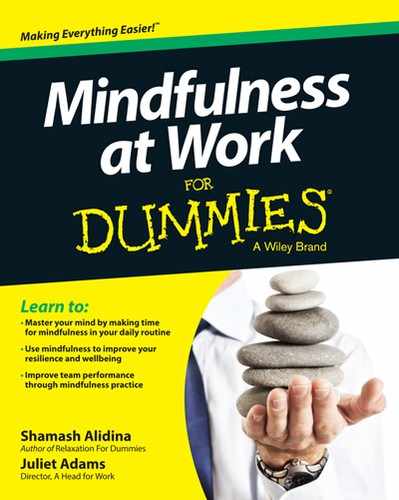Appendix A
Answers to Learning Check Questions
This appendix presents the answers to the Mindfulness at Work Training (MAWT) learning check questions in Chapter 6.
Week 1 Learning Check
The answers to the week 1 learning check are as follow:
- Mindfulness is ‘paying attention, on purpose, to the present moment without judgement’. Mindfulness is all about training your brain to become more aware of what is happening as it is happening. It cultivates awareness of your thoughts, emotions and body, and the interplay between them. Mindfulness is experiencing the present moment with openness and curiosity, without judging it as good or bad or trying to categorise it.
- Mindfulness:
- Can thicken those parts of the brain’s cerebral cortex responsible for decision making, attention and memory.
- Reduces the tendency for the brain to default to habits and ways of thinking based on past experiences.
- Helps you balance left- and right-brain activity.
- The brain’s tendency to work on auto-pilot is a good thing because it frees your working memory to do more things. However, the brain working on auto-pilot is also a bad thing because people make decisions and act based on old information, which may or may not be relevant or appropriate.
- Being in the present allows you to see things as they really are in this moment rather than how you think they are, which may be inaccurate. It allows you to make wiser decisions based on facts rather than passing thoughts.
Week 2 Learning Check
The answers to the week 2 learning check are as follow:
- True. My body really can detect my thoughts before I have consciously registered them myself.
- Approach mode is when you approach and explore things in the present moment with an open mind. It creates a happier, more open approach to work.
- Avoidance mode is when you expend energy in trying to avoid thinking about or exploring emotions or situations, especially those you find difficult or challenging. Working in avoidance mode can lead to a downward mood spiral.
Avoidance mode is the human brain’s default mode for most people – your brain tries to maximise reward and minimise threat so you may often avoid approaching things you find difficult or challenging.
- False. At times many people become bored or frustrated with mindfulness practice. That’s fine; just keep working at it. Each time you practise, you’re strengthening your brain’s ability to be mindful. Doing exercises in the gym may feel boring but you still get results – the same goes for mindfulness.
- False. The sensations you feel can vary from day to day, minute to minute. Some people never feel any sensations in certain parts of their body, which is fine. Focusing your attention on a specific part of the body and seeing what (if anything) you notice is what’s important, not the feeling itself.
..................Content has been hidden....................
You can't read the all page of ebook, please click here login for view all page.
